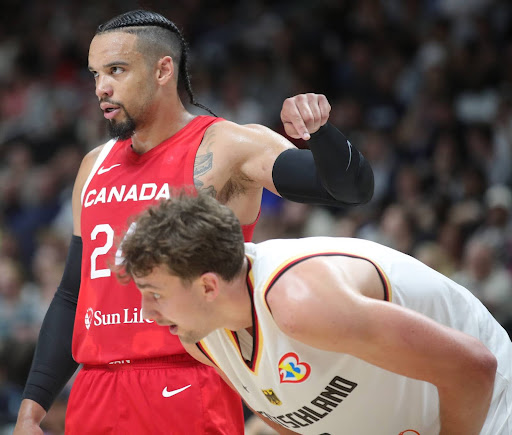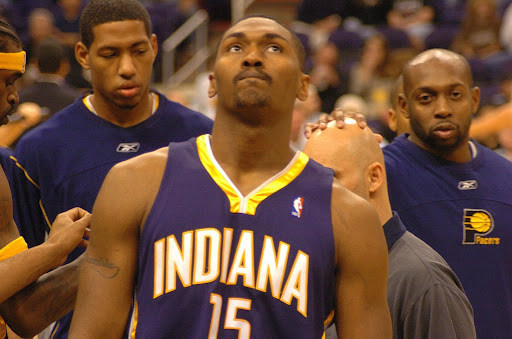
Everyone loves a good villain origin story. Someone who brings passion and excitement to every game, someone whom everyone can collectively root against, someone who can talk the talk and back it up.
The villain can transform a great game into an all-time classic. The added layer of drama, trash talk, and brewing rivalries tends to bring the best out of players. The 90’s and early 2000’s had plenty of these villains: the Bad Boy Pistons terrorizing the league, Reggie Miller torching the New York Knicks, or Ron Artest creating such a large brawl that it was named “Malice at the Palace.”
But the villain archetype is not as common anymore, and it is slowly becoming a dying breed. The NBA is focused on portraying the positive aspects of the game and has implemented stricter rules and penalties for on-court altercations. While villains had room to work earlier, Players are now getting ejected for dunking on another player and hitting the “too little” celebration. Instances like these show why players aren’t inclined to talk trash or engage in physical confrontations.

(Willie Stark (Wikimedia)
In recent years, Dillon Brooks has taken on this challenge, quickly becoming the NBA enemy #1. Brooks infamously nicknamed himself “Dillon the Villain,” and he’s known for his myriad of questionable antics. He has hit several players, ran into and pushed a cameraman without apologizing, and talks an unbelievable amount of trash.
Although I don’t necessarily condone this type of behavior, I love the intensity and energy he brings to every matchup. Any good story relies on a strong, likable protagonist, but it’s the antagonist that tests their limits and creates the conflict. Dillon Brooks has mastered the role of an antagonist through his “Dillon the Villain” character.
Whether it is through his physical play or horrendous (amazing) trash-talking, “Dillon the Villain” creates so much tension that it becomes the talk of the league, and players have no choice but to respond. This fuels rivalries and lights the competitive fire in his opponents, and fans like myself are hyped knowing that we will be seeing these players’ best performances on the court.
Just as any good story keeps you guessing, he is such an unpredictable character that constantly keeps us on our toes. One day, he might get himself ejected from the game. Another day, he may claim he is the best player in the world. You never really know what he’ll choose to do next, and that makes the narrative dynamic and exciting.
Through his “Dillon the Villain” persona, Brooks has recognized the compelling nature of an antagonist in his narrative. He seems to understand the theatrical aspects of competition and successfully engages the fans, his audience. His elaborate storylines are not just limited to the court, as he understands the power of creating such a character.
The villain doesn’t just serve as a foil but also mirrors certain qualities of the hero. The villain’s ambition often matches or even exceeds that of the hero, which sets an extremely high bar that the hero must surpass. In the case of “Dillon the Villain,” he forces and motivates other players to step their game up and meet him face-to-face, which creates legendary and unforgettable moments for us fans. And there could not be a better example of this than last year’s playoffs.
Last season, Dillon Brooks was part of the up-and-coming Memphis Grizzlies. His team secured the two-seed and were facing off against a 38-year-old Lebron James and the Los Angeles Lakers in a 7-game series.
After the Grizzlies won Game 2, “Dillon the Villain” had some very interesting words . “I don’t care – [Lebron is] old. You know what I mean?” he said. “I poke bears. I don’t respect no one until they come and give me 40.”
Even at 38 years old and nearing the end of his career, Lebron is not someone to talk trash to. He is a 4-time NBA Champion, a 4-time MVP, and the all-time leading scorer in NBA history. He has a never-back-down mentality and does whatever it takes to win. Brooks poked the biggest and strongest bear of them all.
These quotes also fired up fans, as they could not wait to see what would happen in the next few games. Would Brooks’ words completely backfire on him, or would he back them up by winning the series? The narrative took an interesting turn, with the tension and expectations at an all-time-high. The stage was set for a showdown that would capture the essence of competition at its finest.
The following games would unfold like a perfectly scripted story. Brooks had previously told reporters that Lebron could not drive left; in Game 4 with 30 seconds left, Lebron drove left with Brooks guarding him and hit the game-winning layup. Each basket served as a testament to his refusal to be outplayed by the villain. As a cherry on top, he dropped 20 points and 20 rebounds, 40 total as Brooks asked.
As if things couldn’t get worse for Brooks, the Lakers beat the Grizzlies in Game 6 by exactly 40 points. “Dillon the Villain” had fallen, and the hero had risen. The villain’s words backfired, igniting Lebron James to drop a series of legendary performances. It was almost poetic, reminding us that while the villain starts the conflict, the hero controls the ending.
Dillon Brooks could not have played the role of “Dillon the Villain” any better. From an entertainment standpoint, this Lakers-Grizzlies series would have been much less exciting without all the added drama and tension. The villain’s defeat ultimately reaffirms that the hero prevails, and such narratives are what captivate us fans and make us love the game of basketball even more.
